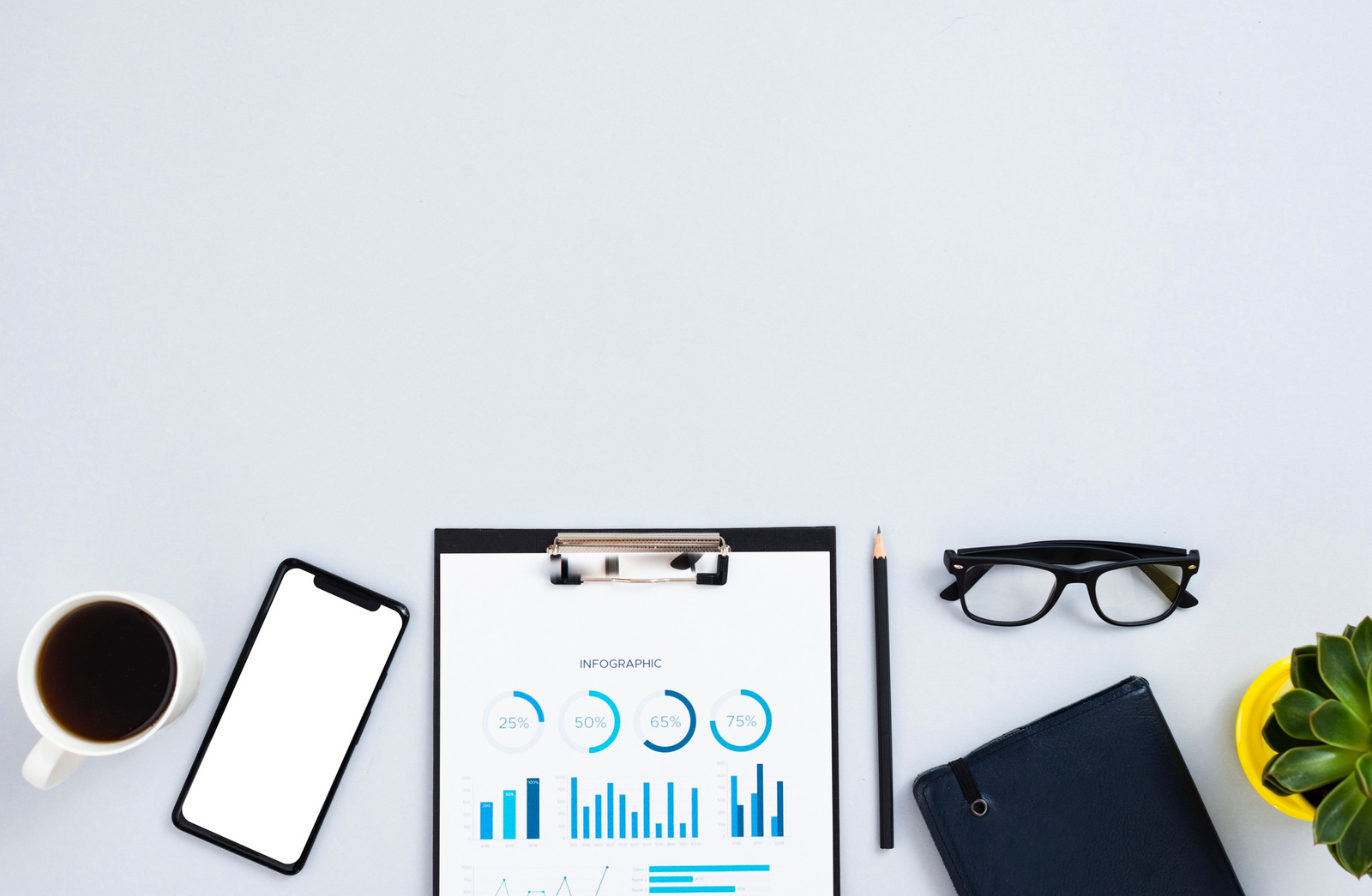In a world where social media plays such an important role in our day-to-day lives, it's no surprise that more and more people are turning to this virtual side of life. And we can’t blame them.
Imagine social media as a new world, another universe where you still have to pay for what you do. While money is still needed for ads and promotions, the real currency in this world is the engagement rate.
Developing a strong social media strategy involves focusing on the right social media metrics to ensure you're reaching and engaging with your audience effectively.
In this article, you will learn what engagement rate is, why it is so important, and how to calculate it properly for each social platform.
The math behind engagement rate on social media
- What is an engagement rate?
- Why is it important to calculate your engagement rate on social media?
- How to calculate your engagement rate for each social media platform
- How to calculate your Facebook engagement rate
- How to calculate your Instagram engagement rate
- How to calculate your X (Twitter) engagement rate
- How to calculate your LinkedIn engagement rate
- How to calculate your YouTube engagement rate
- How to calculate your TikTok engagement rate
1. What is an engagement rate?
The definition of engagement rate is a metric that measures how actively your audience interacts with the content you publish. Depending on each platform, your followers can interact with your brand through likes, comments, shares, saves, follows, mentions, or DMs.
As you can determine, calculating your engagement rate is key if you want to measure how good your content is performing (or not performing, in which case you need to change your social media strategy).
2. Why is it important to calculate your engagement rate on social media?
When they want to get accurate performance data, marketers take into account metrics such as follower growth, reach, or impressions, but they will always look carefully at the engagement rate.
After all, engagement is the one metric that will give you a whole new perspective on your performance on social.
Wondering why?
It's because of the interaction.
Social media is meant to make people interact with the content and interact with each other. That’s when you know that what you do on the platform starts to bring true value.
Implementing social media best practices, such as posting consistently, using high-quality visuals, and engaging with your audience, can significantly boost social media interactions.
Engagement rate is the one and only metric that will always tell you if your content resonates with your audience.
For example, the education industry is a major success story when it comes to education. This particular field enjoys surprising amounts of engagement, and the audience seems to really resonate with the content shared by educational institutions.
We talk about this at length in our article about social media in education.
Here at Socialinsider, we are big fans of engagement.
Given its importance in social media reporting, we always give it a top spot in our dashboards and feature it in our top metrics, as you can see for yourself in the screenshot below.
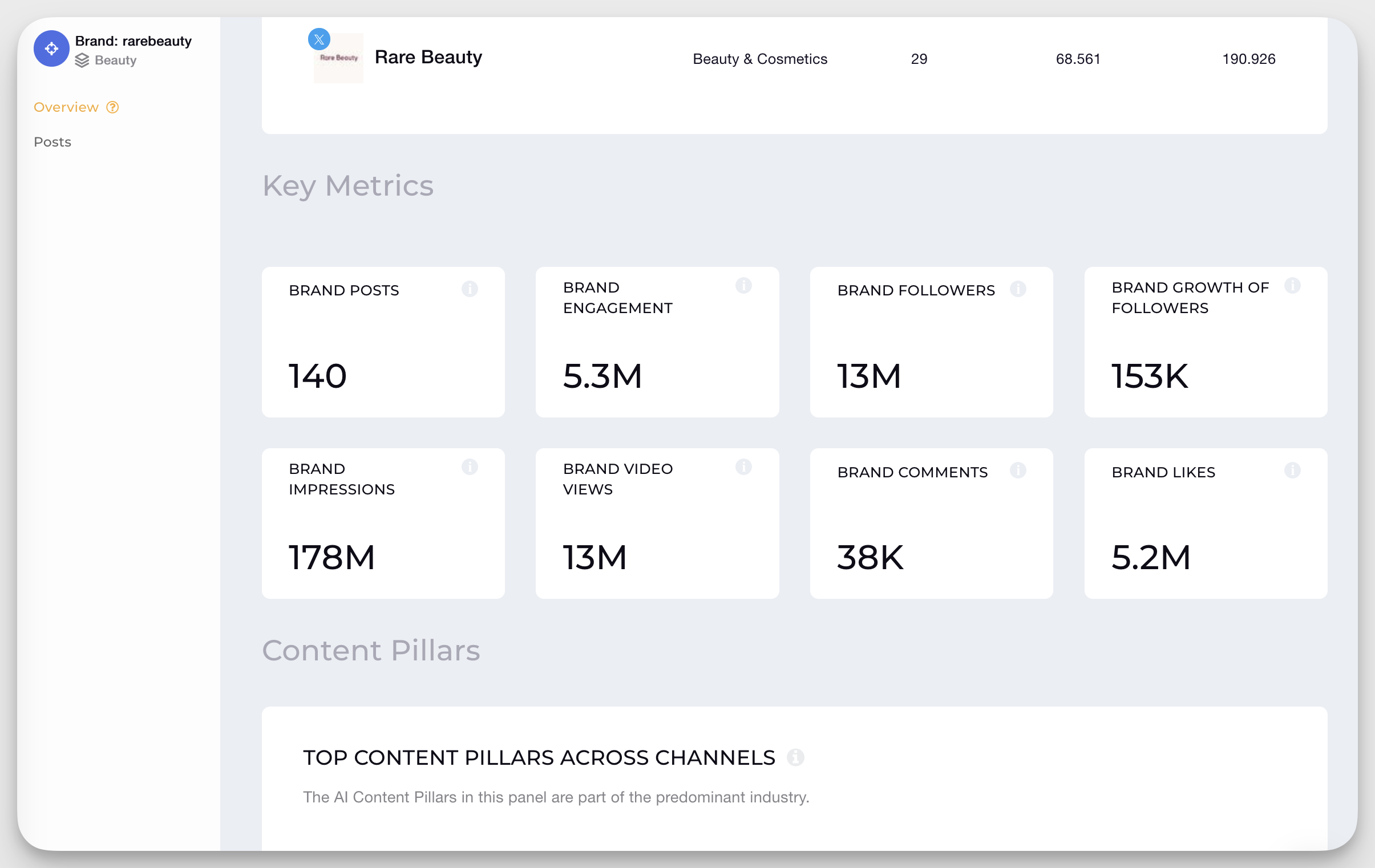
Engagement, in all its variations, also has a place in competitors analysis.
Through the Benchmarks feature in Socialinsider, you can always find competitive data for engagement highlighted in the Profiles Overview section.
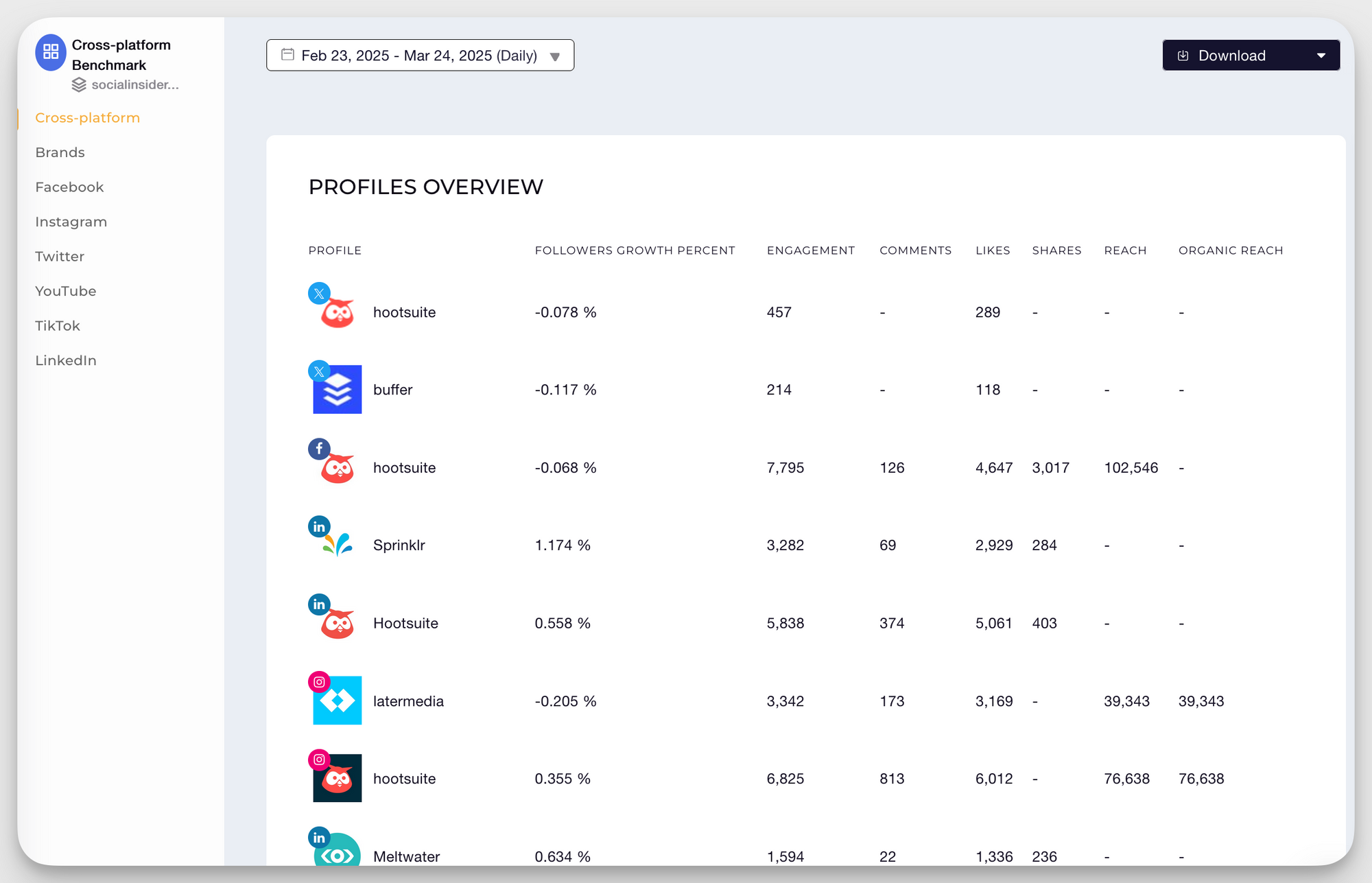
Is engagement a major KPI for your brand? Then, you can track this metric across multiple channels to decide where to invest more time and resources once you see which platform is most engaging.
Here's an example.
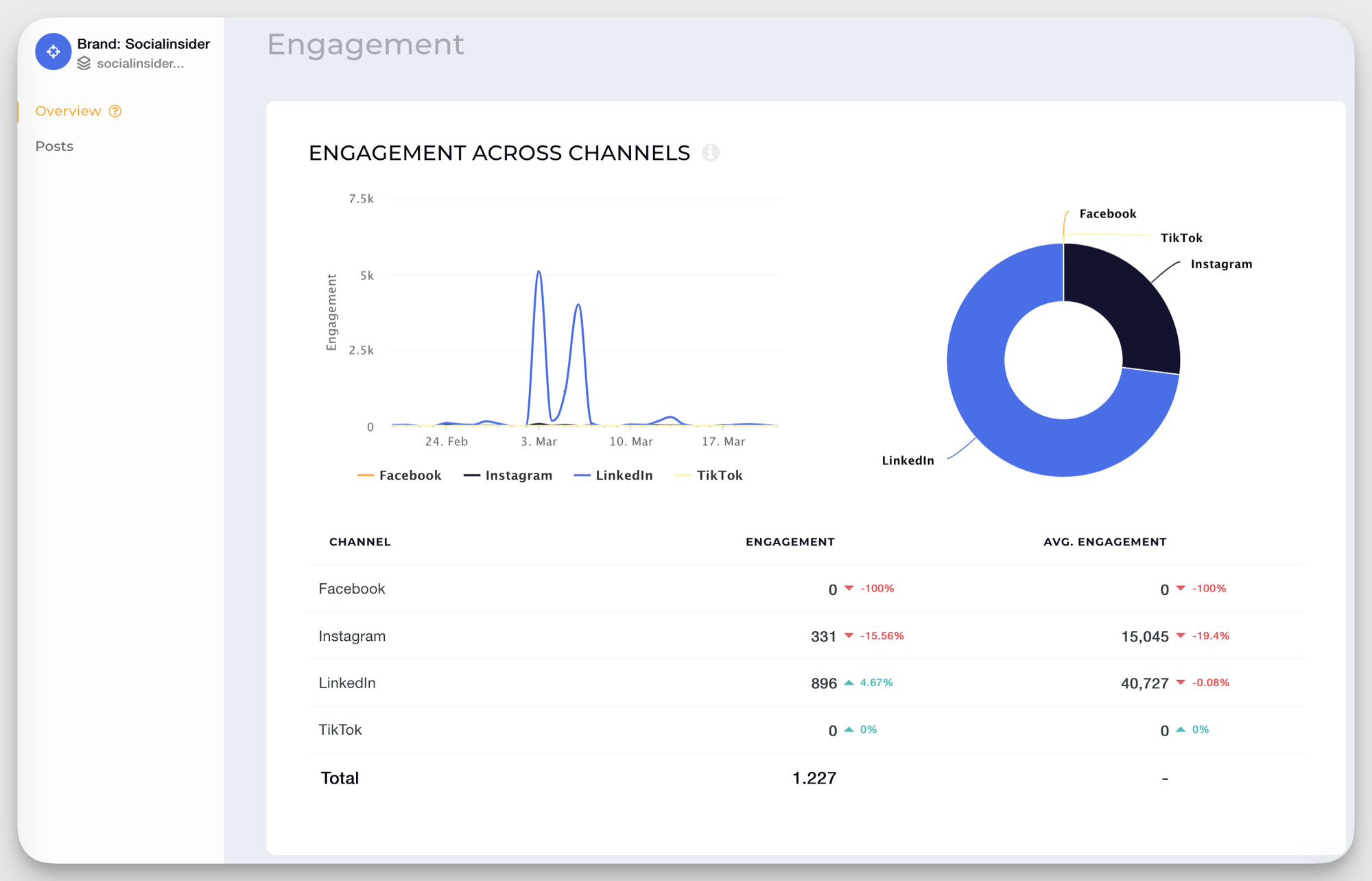
Judging by this data, LinkedIn has both the highest engagement and engagement rate out of the two platforms added, so it makes sense for this brand to focus its efforts on that channel for even better results.
Keep in mind: Relevant as it may be, by itself, engagement only counts the reactions you receive when sharing social media content - likes, comments, shares etc. What it doesn't do is take into consideration your audience size.
If you want to get a highly precise bird's eye view perspective of how invested your audience is in the content you share, always check the engagement rate.
Now, let’s see how to calculate the engagement rate for each platform.
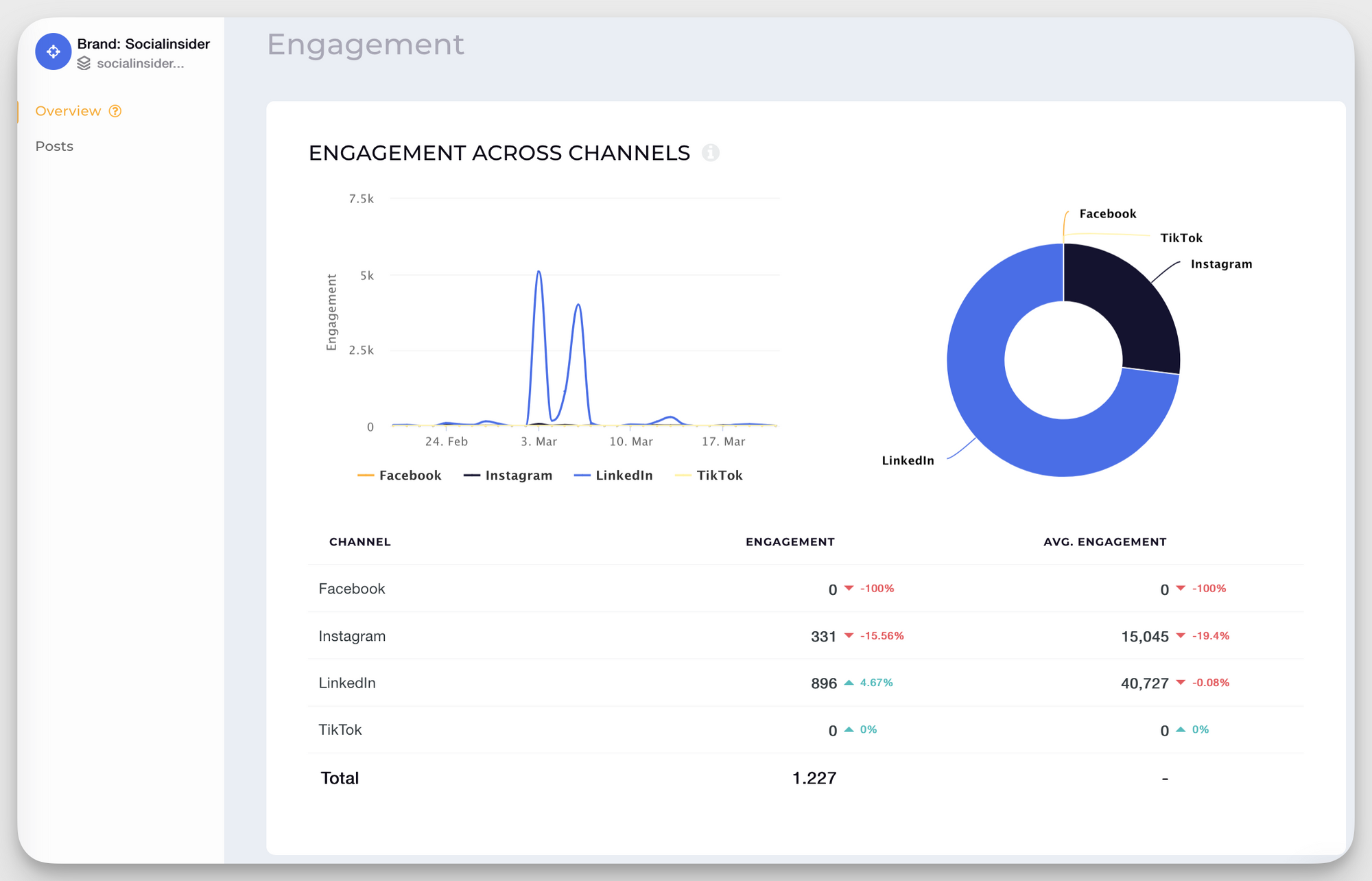
Get detailed social media analytics
Understand what are your best performing platforms and how each of them contributes to creating deeper relationships with your audiences.
Start your 14-days FREE Socialinsider trial!3. How to calculate your engagement rate for each social media platform
How to calculate your Facebook engagement rate
When it comes to Facebook engagement, social media managers usually report engagement by fans and followers since engagement by reach is only available for owned accounts.
And if you want to compare yourself to your competitors, then you should definitely look into what this metric is telling you.
Facebook's definition of post engagement is the following:
The number of times that people engaged with your posts through reactions, comments, shares, and clicks.
Now, let’s turn to the algorithm that Socialinsider uses for Facebook:
The sum of reactions, comments, and shares received on the posts published in the selected time period.
And since the average value is the one that we're interested in, here's how Socialinsider calculates the average engagement rate on Facebook:
The average engagement rate per post by followers on Facebook is calculated as the total engagement (reactions, comments, and shares) divided by the number of posts the page published. The result is then divided by the number of followers, and all multiplied by 100.
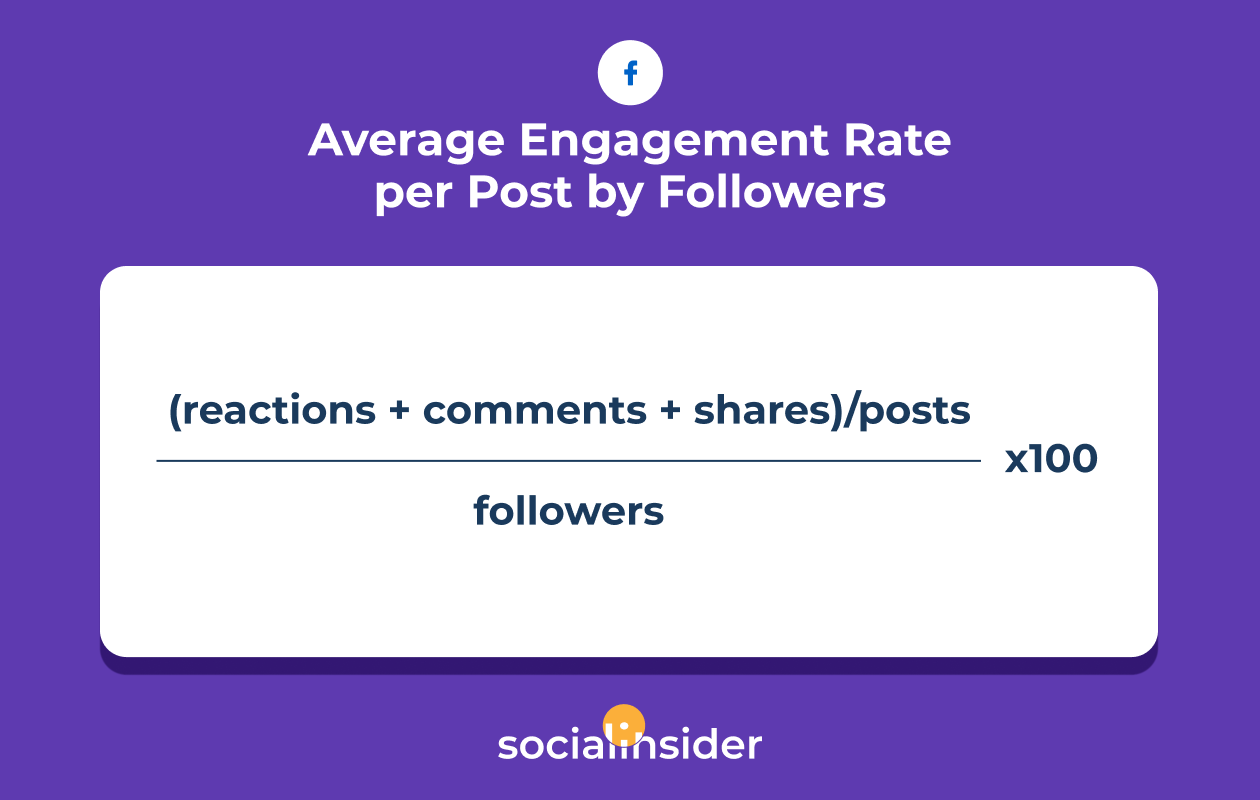
But, if you want a more in-depth look into your performance, you can always take a look at your average engagement rate by reach.
The average engagement rate per post by reach on Facebook is calculated as the total engagement (reactions, comments, and shares) divided by the number of posts the page published. The result is then divided by the total reach, and all multiplied by 100.
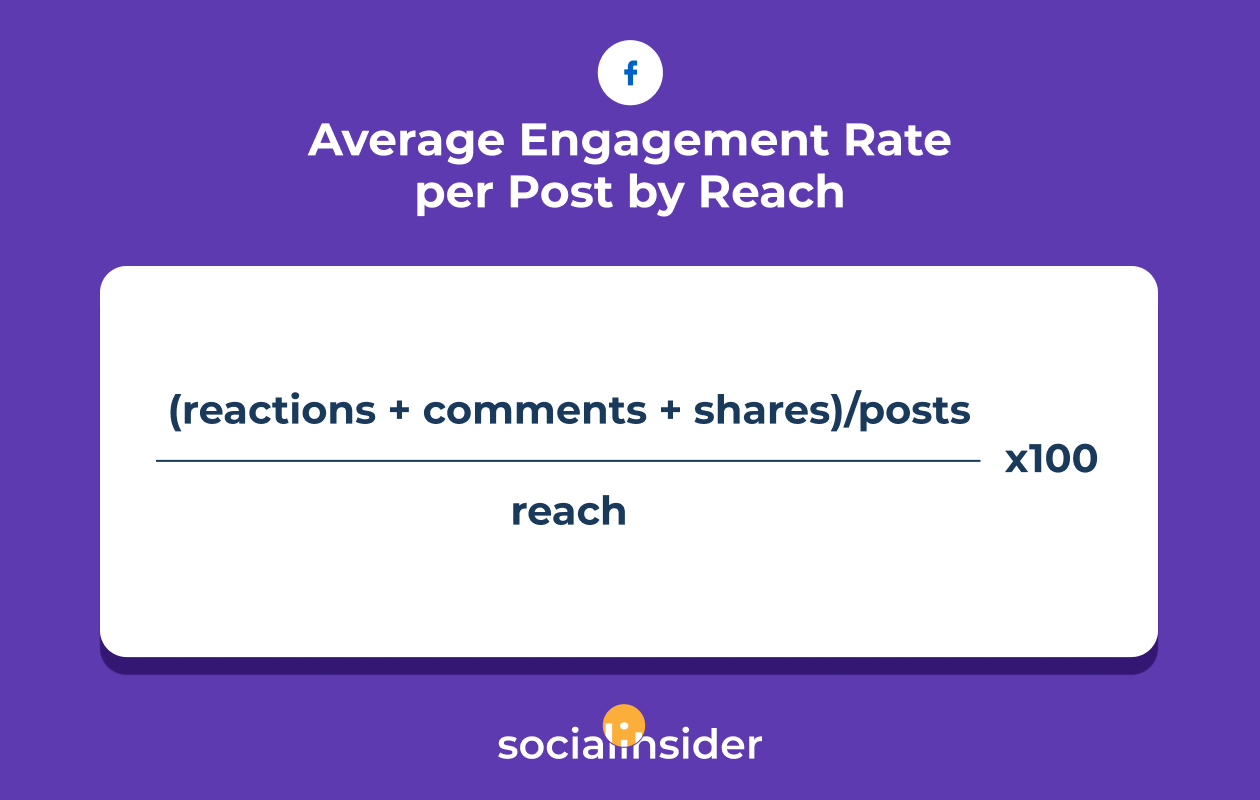
Keep in mind:
- Engagement = The sum of reactions, comments, and shares received for the posts published in the selected time period.
- Average Engagement = The engagement of the posts (reactions, comments, and shares) divided by the number of posts published in the selected period.
To get advanced insights about Facebook engagement beyond what Meta Bussiness Suite can offer, you need to explore some of the top Facebook analytics tools on the market.
Wanna know what your Facebook engagement rate is? Use our free Facebook engagement calculator.
How to calculate your Instagram engagement rate
As mentioned before, on Instagram you’ll encounter the same situation with the engagement rate by followers and by reach.
This means that reach is an Instagram metric available only for owned accounts.
That’s why we should consider both average engagement rate by followers and average engagement rate by reach, depending on the data that we want to report.
Instagram's formula for engagement is the sum of likes, comments, and saves that you receive on the posts you publish.
However, Socialinsider doesn't use this formula because Instagram API doesn't offer access to the saves metric for competitors' profiles. In this way, without adding the number of saves, you're able to perform a quick social media competitors analysis and get insightful Instagram benchmarks.
Digging deeper, the average engagement rate will be defined as follows:
The average engagement rate per post by followers on Instagram is calculated as the total engagement (likes and comments) divided by the number of posts the profile published. The result is then divided by the number of followers, and all multiplied by 100.
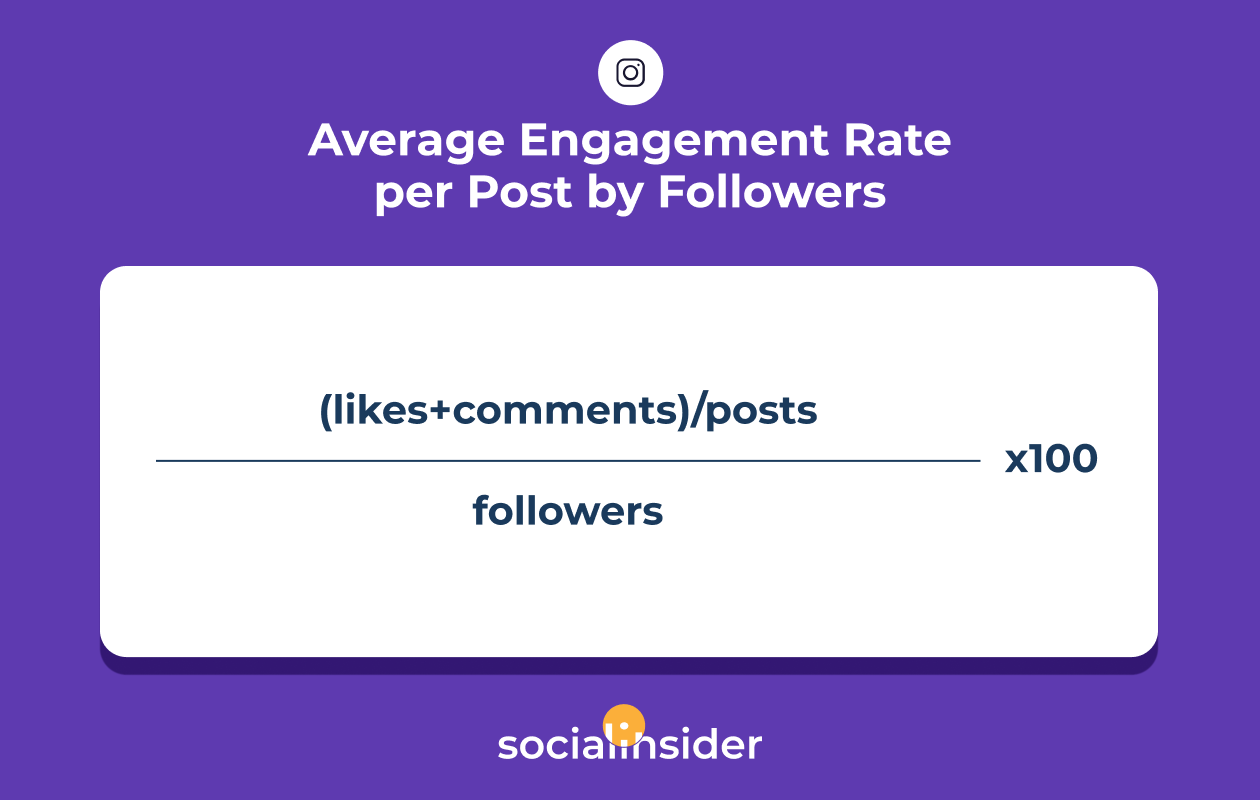
The average engagement rate by reach will be indeed similar to what we've seen on Facebook.
The average engagement rate per post by reach on Instagram is calculated as the total engagement (likes and comments) divided by the number of posts the profile published. The result is then divided by the total reach, and all multiplied by 100.
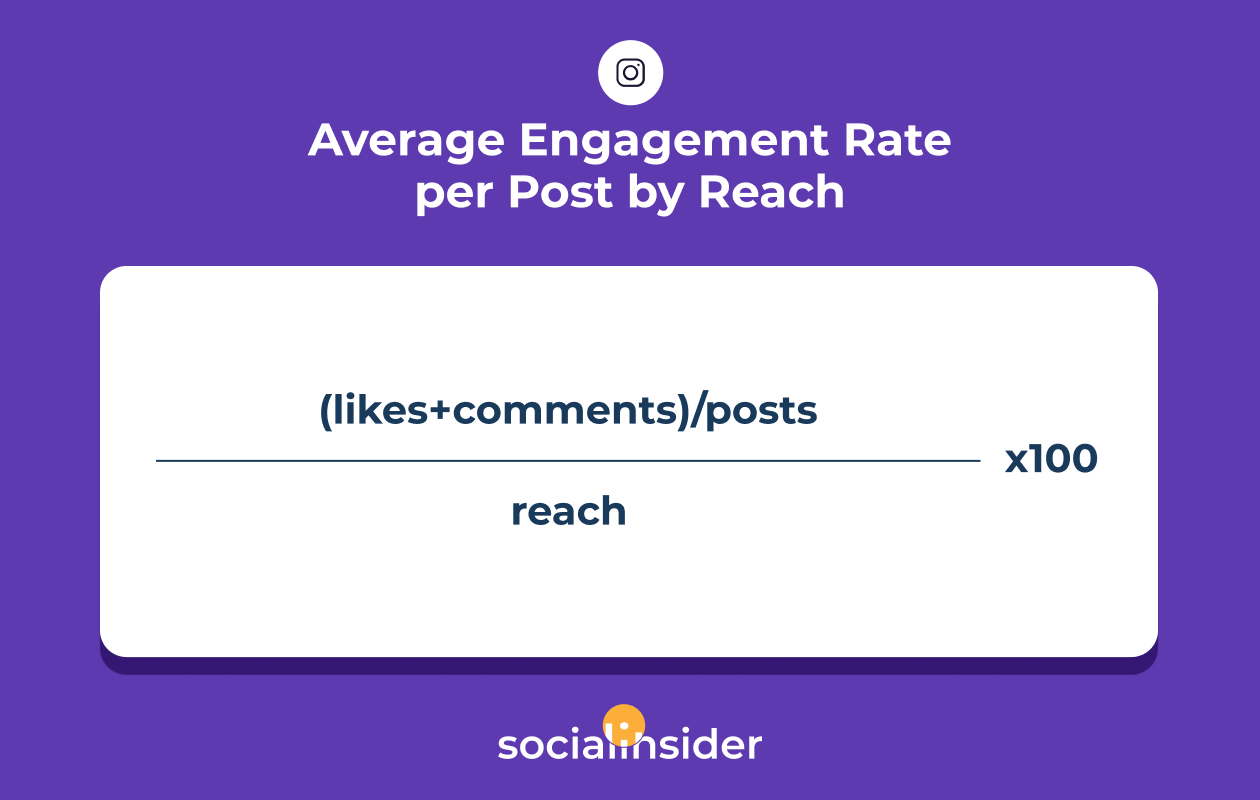
Keep in mind:
- Engagement = The number of likes and comments received for the posts published in the selected time period.
- Average Engagement per Post = The engagement of the posts (likes and comments) divided by the number of posts published in the selected period.
Wanna know what your Instagram engagement rate is? Use our free Instagram engagement calculator.
How to calculate your X (Twitter) engagement rate
A social media analytics tool will always give you more insights into your performance on a specific platform, and Twitter is no exception.
Twitter defines its engagement as the total number of times a user interacted with a Tweet, including retweets, replies, follows, likes, links, cards, hashtags, embedded media, username, profile photo, or Tweet expansion.
We should note that Twitter calculates the engagement rate by impressions, as follows: Number of engagements divided by impressions.
Socialinsider defines Twitter engagement as the sum of likes and retweets received for the tweets published in the selected time period.
For more insights, you should look into the average engagement rate.
The average engagement rate per tweet by followers on Twitter is calculated as the total engagement (likes and retweets) divided by the number of tweets the profile published. The result is then divided by the number of followers, and all multiplied by 100.
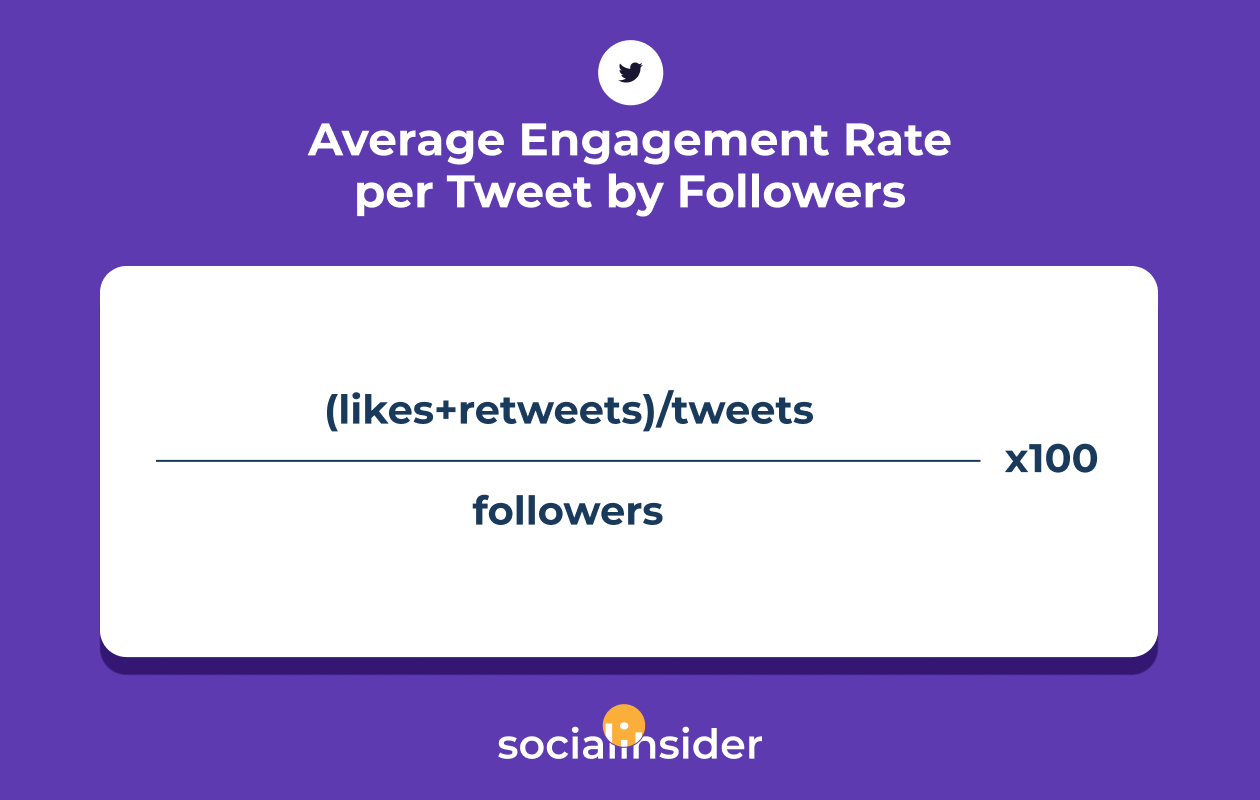
Keep in mind:
- Engagement = The number of likes and retweets received for the tweets published in the selected period.
- Average Engagement = The engagement of the tweets (likes and retweets) divided by the number of tweets published in the selected time period.
However, if you're interested in calculating your Twitter average engagement rate by impressions, you can use the following formula.
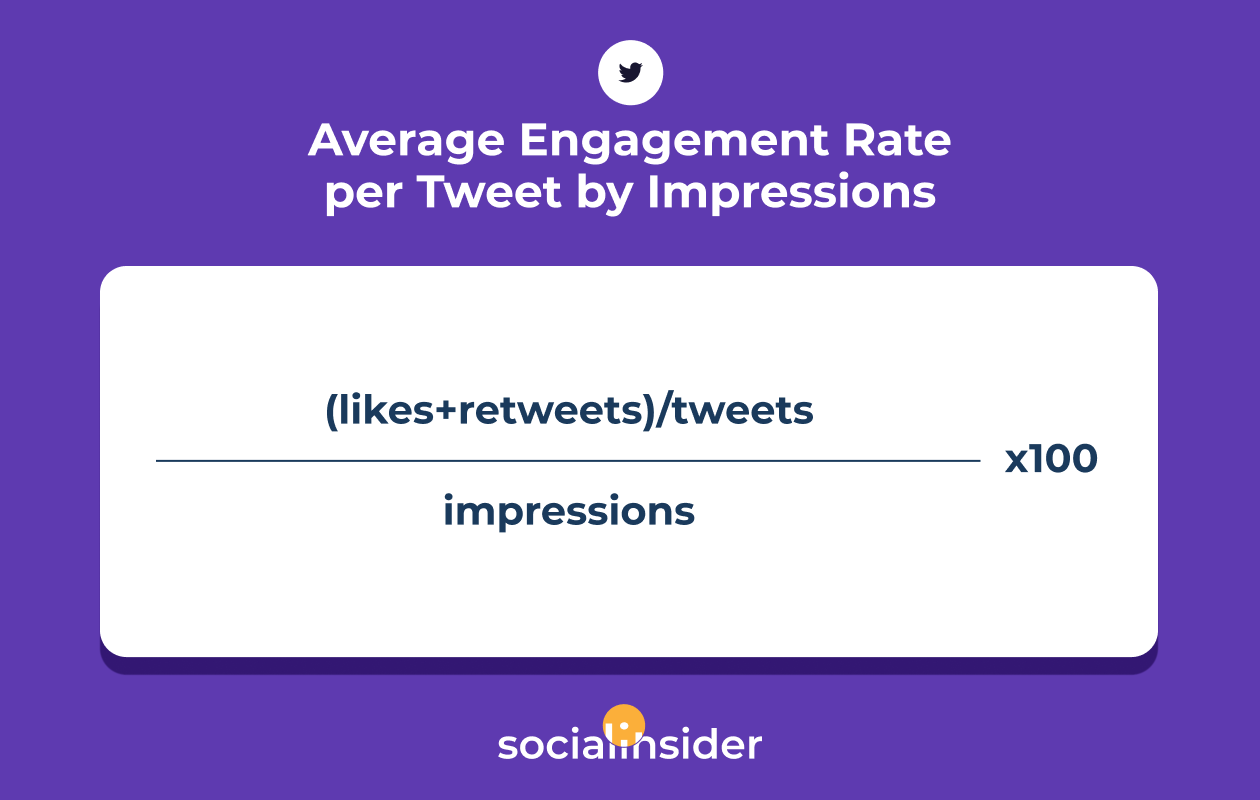
Stay tuned! Our free X (Twitter) engagement calculator is coming soon.
How to calculate your LinkedIn engagement rate
LinkedIn lives up to the hype when it comes to engagement, both literally and analytically. People engage a lot here, and data never lies. Actually, engagement is one of the most important LinkedIn metrics.
LinkedIn defines its engagement as the sum of clicks, likes, comments, shares, and follows - while the engagement rate on LinkedIn is calculated by the number of impressions.
On Socialinsider, you'll find the LinkedIn engagement as the sum of likes, comments, clicks, and shares received on the posts published in the selected time period.
Going back to the metrics, here’s how to measure the engagement rate on LinkedIn.
The average engagement rate per post by impressions on LinkedIn is calculated as the total engagement (likes, comments, clicks, and shares) divided by the number of posts the profile published.
The result is then divided by the number of impressions, and all multiplied by 100.
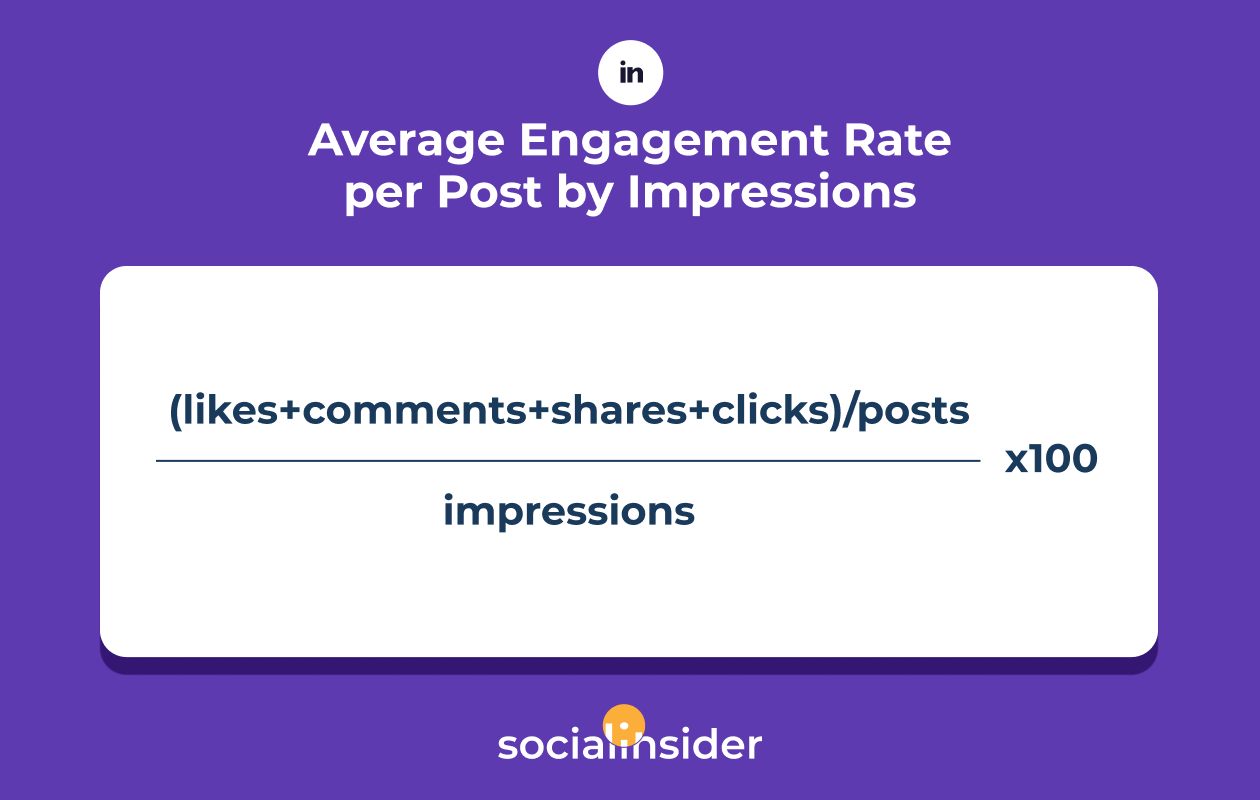
Keep in mind:
- Engagement = The number of likes, comments, clicks, and shares received for the posts published in the selected time period.
- Average Engagement = The engagement of the posts (likes, comments, shares, and clicks) divided by the number of posts published in the selected time period.
Stay tuned! Our free LinkedIn engagement calculator is coming soon.
How to calculate your YouTube engagement rate
Slowly but surely, YouTube has become the most popular video-sharing platform in the world. It is also the second-largest search engine globally, making it a very attractive place to share some content right now.
And this means that we have to turn to data so we can do the magic.
According to its insights data, YouTube engagement metrics (views, likes, dislikes, and subscriptions) reflect how many times a video or channel has been interacted with.
With Socialinsider, your YouTube engagement will be the sum of likes, comments, and dislikes received on the videos published in a selected time period.
For extra precision, you should always check the average engagement rate, which will give more insights into your performance.
The average engagement rate per video by subscribers on YouTube is calculated as the total engagement (likes, comments, and dislikes) divided by the number of videos the profile published. The result is then divided by the number of subscribers, and all multiplied by 100.
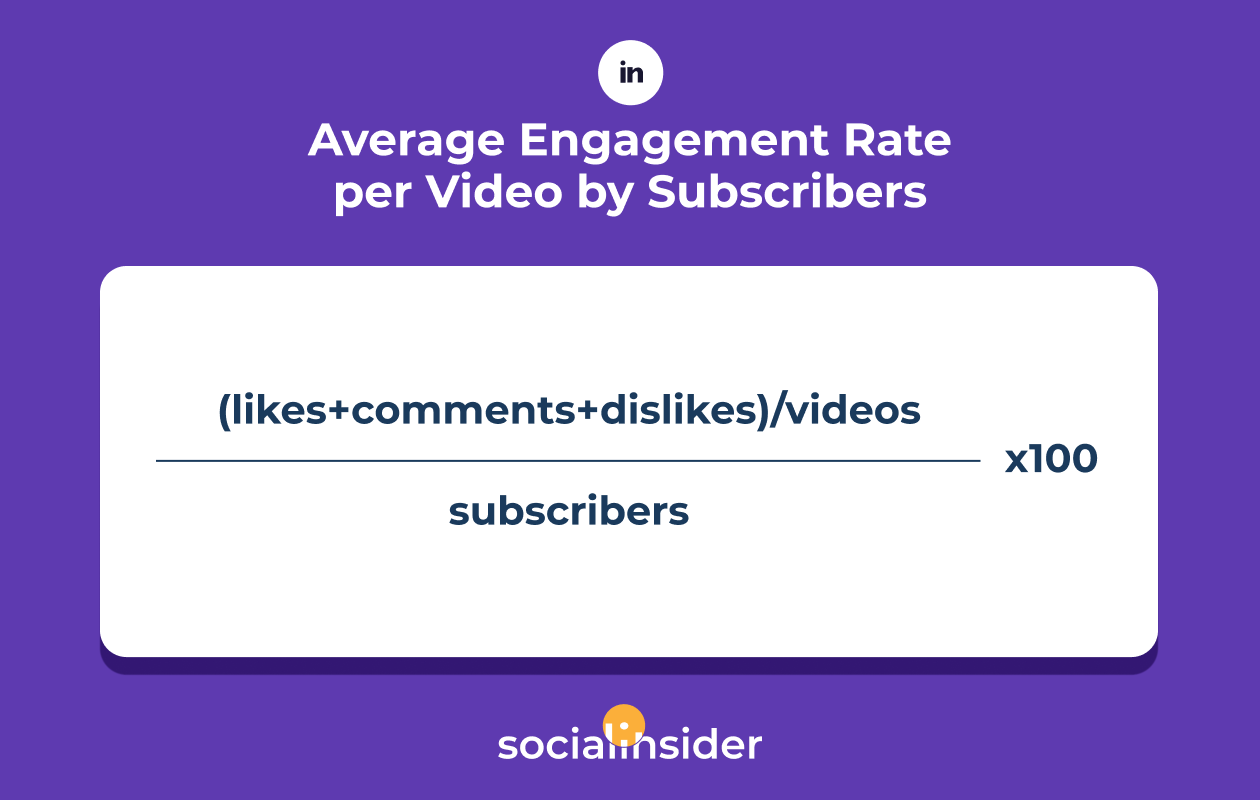
Keep in mind:
- Engagement = The number of likes, comments, and dislikes received for the videos published in the selected time period.
- Average Engagement = The engagement of the videos (likes, comments, and dislikes) divided by the number of videos published in the selected time period.
Wanna know what your YouTube engagement rate is? Use our free YouTube engagement calculator.
How to calculate your TikTok engagement rate
This one is the latest addition to the social media scene, so we need a minute to look into the real insights to see how to measure the success of this huge social network.
TikTok analytics presents the engagement formula as the sum of video views, profile views, likes, comments, saves, and shares.
Unlike the other social networks that are oriented towards the idea of community - where an account's follower count is probably the number one indicator of its popularity, TikTok's case is rather particular.
Because TikTok is a platform where going viral is the endgame, here, the most relevant metric is not the follower base but the number of views, which is exactly why the platform's engagement formula is connected to this metric.
One thing that every social media manager must know is that TikTok's API is highly restricted. Therefore, a social media analytics tool can't have access to all the data.
That's why Socialinsider defines engagement on TikTok as the sum of likes, comments, and shares received on the videos published in the selected time period.
To calculate the average engagement rate per video for TikTok, you should take the total engagement (likes, comments, saves, and shares) and divide it by the number of posts the profile published. The result is then divided by the number of views, and all multiplied by 100.

Keep in mind:
- Engagement = The number of likes, comments, saves, and shares received for the posts published in the selected time period.
- Average Engagement = The engagement of the posts - likes, comments, saves, and shares - divided by the number of posts published in the selected time period.
Wanna know what your TikTok engagement rate is? Use our free TikTok engagement calculator.
How to use engagement rates in your Social Media strategy
Knowing your engagement rate on each platform you have a presence on is only half of the equation; now it's time to make use of these numbers in your overall marketing strategy. Here are a few ways in which you can do so:
- To optimize your content: analyze the posts with the highest engagement rates to understand what resonates with your audience so you can produce more content like that. Take into account that different formats, topics, and posting times can influence your engagement rate, so experiment until you find the lucky formula.
- To gauge your campaigns' success: use engagement rates alongside conversion metrics to evaluate campaign success. Then, use that information to reallocate marketing budgets to the campaigns that brought you the best results.
- For algorithm adaptation: each social media platform has its own quirks, so it's inevitable that you'll have better results on one compared to the others. Which is a good idea to allocate more resources to the platform where you exceed the benchmarks (check out our reports to find out how your engagement compares to the average engagement rate for each platform). Make sure to also keep an eye out for algorithm updates that can impact your engagement rate and adapt your strategy accordingly.
Final thoughts
Now that we've had fun with data, it’s time to create the marketing strategy that best suits your needs, but also according to the platform you’re using.
All these insights are essential for social media, and engagement rate might be more important than you imagined.
A social media analytics tool will help you loads, especially if you want to get in-depth insights.
So don’t forget to keep track of that for your profiles and also look into what your competitors are doing.
Frequently Asked Questions about Engagement Rate
1. What is a good engagement rate?
That depends on the platform. 1% can be a great engagement rate on Instagram, but not so good on TikTok. Check out our social media benchmark reports to find out the average engagement rate for each platform.
2. Is engagement rate a good metric?
Engagement rate is one of the key metrics that measure content performance. Social media strategists track engagement rate to understand how much their audience resonates with the content they share.
3. How do you benchmark engagement rate?
There are multiple ways to do so: you can benchmark your engagement rate against yourself to see how your content performed over time, you can benchmark your engagement rate against your competitors using platforms like Socialinsider, or you can benchmark your engagement rate against your industry or the average engagement rate for that platform (check out our Resources section for more details).
4. Can engagement rate be more than 100?
The engagement rate cannot surpass 100 as it is a metric designed as a percentage (out of 100).
5. What can influence engagement rate?
Many factors can influence engagement rates, such as content quality and relevance, audience demographics and preferences, posting timing and frequency, as well as platform specific factors.
